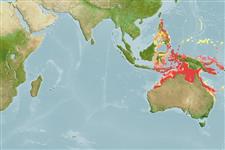Common names from other countries
Environment: milieu / climate zone / depth range / distribution range
Ecologia
marinhas associadas(os) a recifes; intervalo de profundidade 5 - 100 m (Ref. 6390). Tropical; 21°N - 28°S, 117°E - 159°E (Ref. 5222)
Western Pacific: Thailand, Singapore, Philippines, Indonesia, Papua New Guinea, the Arafura Sea (Ref. 9819), Solomon Islands, and Australia (from Houtman Abrolhos in Western Australia to Gladstone, Queensland) (Ref. 3150). This species was formerly listed as occurring in the western Indian Ocean based on a misidentification of Plectropomus pessuliferus.
Comprimento de primeira maturação / Tamanho / Peso / Idade
Maturity: Lm ? range ? - ? cm
Max length : 125 cm TL macho/indeterminado; (Ref. 90102); peso máx. publicado: 25.0 kg (Ref. 5222)
Espinhos dorsais (total) : 7 - 8; Raios dorsais (total) : 10 - 12; Espinhos anais: 3; Raios anais : 8.
Found in protected coastal reef in mixed algae and coral habitat (Ref. 48635). Common on inshore coastal reefs but absent in clear offshore reefs (Ref. 9710). Juveniles have a demersal existence in shallow water in reef habitats, especially around coral rubble (Ref. 27259). Migrate over short distances to spawn, forming aggregations (Ref. 6390). May move into shallow water to feed (Ref. 6390). Eggs float just below the water surface (Ref. 6390). Pelagic larvae are found in habitats similar to those of the adults (Ref. 27260). Juveniles feed on small fish and invertebrates such as crustaceans and squid (Ref. 27261). Commonly used for food. Its flesh is delicate and well appreciated (Ref. 5503). Solitary (Ref 90102).
Ciclo de vida ou comportamento de acasalamento
Maturities | Reprodução | Spawnings | Egg(s) | Fecundities | Larvas
Confirmed for diandry (Ref. 103751).
Heemstra, P.C. and J.E. Randall, 1993. FAO Species Catalogue. Vol. 16. Groupers of the world (family Serranidae, subfamily Epinephelinae). An annotated and illustrated catalogue of the grouper, rockcod, hind, coral grouper and lyretail species known to date. Rome: FAO. FAO Fish. Synop. 125(16):382 p. (Ref. 5222)
Status na Lista Vermelha da UICN (Ref. 130435)
CITES (Ref. 128078)
Not Evaluated
Ameaça para os humanos
Reports of ciguatera poisoning (Ref. 30298)
Uso pelos humanos
Pescarias: espécies comerciais; Aquacultura: espécies comerciais; peixe esportivo: sim
Ferramentas
Relatórios especiais
Baixar XML
Fontes da internet
Estimates based on models
Preferred temperature (Ref.
115969): 26.1 - 28.8, mean 27.8 (based on 466 cells).
Índice de diversidade filogenética (Ref.
82804): PD
50 = 0.5078 [Uniqueness, from 0.5 = low to 2.0 = high].
Bayesian length-weight: a=0.01122 (0.00581 - 0.02169), b=3.05 (2.89 - 3.21), in cm Total Length, based on LWR estimates for this species & (Sub)family-body (Ref.
93245).
Nível Trófico (Ref.
69278): 4.1 ±0.70 se; based on food items.
Resiliência (Ref.
120179): médio(a), tempo mínimo de duplicação da população 1,4 - 4,4 anos (K=0.21; tm=2-3).
Fishing Vulnerability (Ref.
59153): Moderate to high vulnerability (51 of 100).
